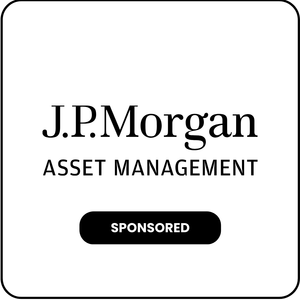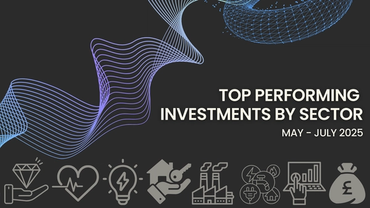Top Performing ETFs, Funds, and Investment Trusts | August - October 2025
By Boring Money
7 Nov, 2025
It was a buoyant quarter for global risk assets, with a cut in US interest rates, some certainty over tariffs, and better economic data contributing to investor confidence. The Liberation Day panic retreated into the distance, replaced by new worries over the soaring valuations of AI-related stocks.
Many of the fears surrounding the US economy did not materialise. Inflation remained relatively benign, though there is some debate on whether the tariff impact could yet be felt in consumer prices. The Federal Reserve was sufficiently relaxed about inflation to contemplate loosening monetary policy, cheering markets with cuts in September and October.
Nevertheless, the ongoing strength of gold and other precious metals showed that investors were not entirely sanguine about the environment. Government debt continues to spiral higher, with the Big Beautiful Bill contributing to the rising deficit. Equally, there are growing nerves over the dominance of AI on economic and stock market growth. The latest round of technology results revealed punchy capital spending on AI, while the revaluation of ChatGPT also gave investors pause for thought.
For the time being, these fears were not reflected in the valuations of US technology companies. Technology was the best performing sector over the three month period, rising 15.8%, almost 50% more than any other sector. The only signs of weakness came towards the end of the period, when the technology giants released their third quarter earnings. In some cases, AI spending proved too high, and the growth rates too low, for investors’ tastes. In particular, Meta and Microsoft saw investors push back over rising capital expenditure.
Healthcare was another notable winner over the quarter. This marks a notable reversal from its recent run of weakness and could suggest a brighter future for the sector. It has been held back by worries over the impact of the Trump administration. There have been concerns over drug pricing, over tariffs, and over Health Secretary Robert F. Kennedy Jr’s erratic stewardship of the various regulatory bodies. The disruption created by the DOGE spending cuts has also deterred investors.
Most of these worries appear to have been resolved. The tariff regime for pharmaceutical companies is now clear, while normal service has been restored at the major Federal agencies, including the Food and Drug Administration. This is having an impact on the pipeline of drug approvals and removing a major headwind for the sector.
Consumer discretionary stocks were also strong, in notable contrast to consumer staples, which sat at the bottom of the sector tables over the quarter. This strength may be attributed to a relief rally on tariffs and to the ongoing strength of consumer spending around the world. It had been expected that tariffs and inflationary pressures might knock consumer confidence, but they have shown their willingness to keep on spending. This has been particularly true for higher-income households.
Consumer staples may have suffered over the quarter because of their defensive qualities. As markets rallied, areas such as real estate, consumer staples, and financials have been left behind.
As investors look out to the remainder of 2025, there remain concerns over market complacency. Has the impact of the tariffs been fully felt in markets or is there more turmoil ahead? Might AI-related investments be due for a pullback?
In its latest outlook, JP Morgan Asset Management concludes:
The consensus market cry is that risk assets look expensive; that view is most likely driven by equity indices reaching all time highs. While it’s true that equity multiples are full by historic standards, it misses the fact that earnings growth, particularly in mega-cap technology, is driving returns – we aren’t seeing undue multiple expansion. When one combines the secular growth coming from the tech sector with a rate cutting backdrop, it’s understandable why equities continue to progress.
Sector performance vs MSCI World, August - October 2025
Hover on the bars below to zoom in on performance
Sector/Index | Initial Investment | Balance in August | Balance in September | Balance in October |
Information Technology | £1,000 | £984 | £1,061 | £1,158 |
Industrials | £1,000 | £985 | £1,012 | £1,047 |
MSCI World | £1,000 | £1,005 | £1,041 | £1,088 |
Consumer Discretionary | £1,000 | £1,020 | £1,052 | £1,095 |
Financials | £1,000 | £1,016 | £1,029 | £1,034 |
Energy | £1,000 | £1,019 | £1,019 | £1,040 |
Utilities | £1,000 | £974 | £1,010 | £1,066 |
Materials | £1,000 | £1,050 | £1,079 | £1,075 |
Telecommunications Services | £1,000 | £1,054 | £1,040 | £1,044 |
Real Estate | £1,000 | £1,006 | £1,013 | £1,012 |
Consumer Staples | £1,000 | £989 | £989 | £1,001 |
Health Care | £1,000 | £1,030 | £1,044 | £1,102 |
Performance is calculated at the end of the month. Data provided by FE FundInfo, correct as at 31st October 2025.
Top performing investments
Key observations
Sector comparison

Cumulative Performance, August - October 2025
Top performers by sector
Category | Top Performer | Investment product | August - October Performance | 3-Year Performance | 5-Year Performance |
Information Technology | Global X Etfs Icav GLOBAL X BLOCKCHAIN UCITS ETF (BKCG) | ETF | 89.5% | 351.2% | N/A |
Healthcare | Seneca Growth Capital VCT | IT | 33.3% | -25.3% | -15.4% |
Consumer Discretionary | Global X China Electric Vehicle and Battery (CAUG) | ETF | 40.5% | -7.8% | N/A |
Materials | Aberdeen Abrdn Future Raw Materials (ARAW) | ETF | 43.5% | N/A | N/A |
Utilities | SPDR® MSCI Europe Utilities (UTIL) | ETF | 10.6% | 62.4% | 68.0% |
Emerging Markets | FSSA Global Emerging Markets Focus | Fund | 9.4% | 49.3% | 57.8% |
Data provided by FE FundInfo, correct as at 31st October 2025.
Sector breakdown
🌐 Information Technology
Name | Investment product | August - October Performance | 3-Year Performance | 5-Year Performance | OCF |
Global X Etfs Icav GLOBAL X BLOCKCHAIN (BKCG) | ETF | 89.5% | 351.2% | N/A | 0.50% |
Global X CleanTech (CTEG) | ETF | 52.9% | -17.6% | N/A | 0.50% |
iShares Blockchain Technology (BLKC) | ETF | 46.7% | 272.2% | N/A | 0.50% |
VanEck Crypto and Blockchain Innovators (DAGB) | ETF | 39.3% | 347.2% | N/A | 0.65% |
HSBC Nasdaq Global Semiconductor (HNSS) | ETF | 35.8% | 197.5% | N/A | 0.35% |
iShares MSCI Global Semiconductors (SEMI) | ETF | 35.2% | 173.0% | N/A | 0.35% |
Van Eck Quantum Computing (QNTG) | ETF | 32.9% | N/A | N/A | 0.55% |
Invesco CoinShares Global Blockchain UCITS ETF (BCHN) | ETF | 31.4% | 182.7% | 185.3% | 0.65% |
VanEck Semiconductor (SMGB) | ETF | 30.1% | 204.6% | N/A | 0.35% |
iShares AI Infrastructure (AINF) | ETF | 28.2% | N/A | N/A | 0.35% |
Data provided by FE FundInfo, correct as at 31st October 2025.
The price of Bitcoin struggled to recover from its crash, and was down 12.35% for the quarter[2]. This is in spite of a Trump executive order in August, which ushered in a more benign regulatory environment for cryptocurrencies. Nevertheless, Blockchain and Crypto-focused ETFs did well, with Mirae Asset Global X Blockchain, iShares Blockchain Technology, VanEck Crypto and Blockchain Innovators and Invesco CoinShares Global Blockchain all in the top 10 performers in the sector over the three months.
Elsewhere, it was the semiconductor specialist ETFs that dominated, after the extent of AI spending became clear.
According to Wall Street estimates, so-called AI hyperscalers in the US and sector companies are expected to spend more than double what they spent in 2022 on data centre capital expenditure in 2025. AI-related capex accounts for about 5 per cent of US GDP and is growing by roughly 10 per cent a year.[3]
The HSBC Nasdaq Global Semiconductor, iShares MSCI Global Semiconductors, and VanEck Semiconductor ETFs were all beneficiaries.
Two notable inclusions in the top 10 this month were VanEck Quantum Computing and Mirae Asset Global X Cleantech. Clean technology and renewable energy have been difficult areas in recent years, but there are signs that sentiment is starting to turn.
⚕️ Healthcare
Name | Investment product | August - October Performance | 3-Year Performance | 5-Year Performance | OCF |
Seneca Partners Limited Seneca Growth Capital | IT | 33.3% | -25.3% | -15.4% | 0.08% |
Global X Genomics & Biotechnology (GNOG) | ETF | 32.0% | -24.1% | N/A | 0.50% |
ARK Genomic Revolution (ARCG) | ETF | 24.7% | N/A | N/A | 0.75% |
WisdomTree BioRevolution (WBIO) | ETF | 23.9% | -16.3% | N/A | 0.45% |
iShares Nasdaq US Biotechnology (BTEK) | ETF | 21.2% | 16.1% | 31.3% | 0.35% |
iShares Biotechnology (IGG) | ETF | 21.0% | 9.2% | 21.1% | 0.45% |
L&G Healthcare Technology & Innovation (DOCG) | ETF | 20.6% | 3.8% | -4.6% | 0.49% |
Invesco Nasdaq Biotech (SBIO) | ETF | 19.7% | 14.4% | 29.8% | 0.40% |
L&G Pharma Breakthrough (BIGT) | ETF | 19.5% | 9.2% | 13.1% | 0.49% |
First Trust NYSE Arca Biotechnology (FBT) | Fund | 18.4% | 17.8% | 24.8% | 0.60% |
Data provided by FE FundInfo, correct as at 31st October 2025.
The top performers were all at the growth end of the spectrum, including the Seneca Partners Limited Seneca Growth Capital VCT, the Mirae Asset Global X Genomics & Biotechnology fund, and the IQ EQ Fund Management ARK Genomic Revolution ETF. The biotechnology sector has been particularly weak: it has had to contend with higher interest rates as well as the broader weakness in the healthcare sector.
With this in mind, it has been a significant beneficiary of both the cuts in US interest rates and a revival of merger and acquisition activity. Biotechnology companies have been takeover targets, with Avidity Bioscience, Tourmaline Bio, Anthos Therapeutics and Intra-Cellular Therapies all snapped up this year.
The healthcare sector has also been caught up in the broader vogue for technology stocks. There is plenty of scope for AI within healthcare, notably in areas such as diagnostics. These areas fared well over the quarter, with the L&G Healthcare Technology & Innovation and Pharma Breakthrough ETFs also among the top performers.
The sector as a whole has benefited from some easing of concern about the regime in the US. Donald Trump has finally announced the level of tariffs on pharmaceutical products, and forged deals with large cap pharma companies on US drug pricing. The impact of the DOGE agenda and RFK Jr on the various Federal healthcare agencies also appears to be diminishing.
🛍️ Consumer Discretionary
Name | Investment product | August - October Performance | 3-Year Performance | 5-Year Performance | OCF |
Global X China Electric Vehicle and Battery (CAUG) | ETF | 40.5% | -7.8% | N/A | 0.68% |
KraneShares Electric Vehicles & Future Mobility Screened UCITS ETF (KARP) | ETF | 33.6% | -8.4% | N/A | 0.72% |
Global X Autonomous & Electric Vehicles (DRVE) | ETF | 28.2% | 32.0% | N/A | 0.50% |
WisdomTree Global Automotive Innovators (CARS) | ETF | 10.5% | 35.4% | N/A | 0.45% |
SPDR S&P U.S. Consumer Discretionary Select Sector (SXLY) | ETF | 10.2% | 57.5% | 84.7% | 0.15% |
Invesco Consumer Discretionary S&P US Select Sector UCITS ETF (XLYP) | ETF | 10.1% | 53.7% | 81.6% | 0.14% |
iShares S&P 500 Consumer Discretionary Sector UCITS ETF (ICDU) | ETF | 10.0% | 57.7% | 73.2% | 0.15% |
SPDR MSCI Europe Consumer Discretionary (CDCE) | ETF | 10.0% | 32.6% | 46.5% | 0.18% |
iShares MSCI Europe Consumer Discretionary Sector (ESIC) | ETF | 10.0% | 32.8% | N/A | 0.18% |
Xtrackers MSCI World Consumer Discretionary UCITS ETF (XWDS) | ETF | 9.4% | 50.1% | 64.6% | 0.25% |
Data provided by FE FundInfo, correct as at 31st October 2025.
However, there is a clear difference between lower and middle/upper income households. The Bank of America Institute says:
Lower-income households showed some spending recovery, but growth remains muted compared to middle- and higher-income groups, likely due to softer wage gains in this cohort. Middle- and higher-income households have stronger wage growth, but higher-income spending is likely also benefiting from wealth effects. The discretionary spending of the top 5% of households by income tends to widen compared to the middle income cohort when the S&P 500 is rising.
This may explain the relatively strong performance of consumer discretionary stocks over consumer staples stocks in the past three months. The consumer discretionary sector has also lagged the index by around 10% for the year to date[4], so this may have been part of a catch-up trade. The sector may also have benefited from some clarity on the tariff situation.
Most of the top performing funds were generalist consumer discretionary companies, including the Invesco Consumer Discretionary S&P US Select Sector, SSGA SPDR MSCI Europe Consumer Discretionary and Xtrackers MSCI World Consumer Discretionary ETFs. However, it was also a strong quarter for electric vehicles after a difficult few months for the sector. The top four funds in the sector were all related to this part of the market.

Data provided by FE FundInfo, correct as at 31st October 2025.
🧱 Materials
Name | Investment product | August - October Performance | 3-Year Performance | 5-Year Performance | OCF |
abrdn Future Raw Materials (ARAW) | ETF | 43.5% | N/A | N/A | 0.45% |
iShares Lithium & Battery Producers (LITM) | ETF | 43.3% | N/A | N/A | 0.55% |
VanEck Rare Earth and Strategic Metals (REGB) | ETF | 42.2% | -26.6% | N/A | 0.59% |
Global X Disruptive Materials (DMAG) | ETF | 37.2% | 23.7% | N/A | 0.50% |
iShares Copper Miners (MINE) | ETF | 35.1% | N/A | N/A | 0.55% |
VanEck S&P Global Mining (GIGB) | ETF | 33.1% | 66.7% | 113.3% | 0.50% |
abrdn Future Supply Chains (ASCH) | ETF | 14.7% | N/A | N/A | 0.60% |
SPDR MSCI World Materials (WMAT) | ETF | 8.0% | 23.2% | 53.8% | 0.30% |
Xtrackers MSCI World Materials (XSMW) | ETF | 8.0% | 23.3% | 54.2% | 0.25% |
Invesco US Materials Sector (XLBP) | ETF | -0.1% | 7.3% | 46.2% | 0.14% |
Data provided by FE FundInfo, correct as at 31st October 2025.
It has been a particularly strong quarter for energy transition metals. Prices have also moved higher over concerns about resource nationalism. China has used its rare earth supplies as a bargaining chip in its negotiations with the US over trade, for example.
The top performing fund, with a startling 43.5% gain over the 3 months is the Aberdeen Future Raw Materials ETF. This invests in companies involved in the exploration, mining, and refinement of materials critical for the green energy transition. The fund incorporates raw materials such as copper, aluminium, lithium, nickel, and rare earth elements.
The other top performers also focused on these ‘strategic’ metals. They included the BlackRock Lithium & Battery Producers ETF, VanEck Rare Earth and Strategic Metals ETF, plus the iShares Copper Miners ETFs. Two generalist materials funds also made the top 10 - SSGA SPDR MSCI World Materials and Xtrackers MSCI World Materials ETFs – though these were some way behind the top performers in the sector, rising just 8% over the period.
🔌 Utilities
Name | Investment product | August - October Performance | 3-Year Performance | 5-Year Performance | OCF |
SPDR MSCI Europe Utilities (UTIL) | ETF | 10.6% | 62.4% | 68.0% | 0.18% |
Xtrackers MSCI Europe Utilities Screened (XS6R) | ETF | 10.4% | 64.0% | 65.9% | 0.17% |
Amundi S&P Global Utilities ESG (WELD) | ETF | 7.4% | 38.6% | N/A | 0.18% |
Xtrackers MSCI World Utilities (XWUS) | ETF | 7.2% | 36.6% | 60.2% | 0.25% |
SPDR MSCI World Utilities (WUTI) | ETF | 7.2% | 36.4% | 59.8% | 0.30% |
Invesco US Utilities Sector (XLUP) | ETF | 6.0% | 26.8% | 60.5% | 0.14% |
iShares S&P 500 Utilities Sector (IUSU) | ETF | 5.3% | 26.2% | 59.6% | 0.15% |
SPDR S&P U.S. Utilities Select Sector (SXLU) | ETF | 5.3% | 26.2% | 59.5% | 0.15% |
Data provided by FE FundInfo, correct as at 31st October 2025.
Markets from August - October broadly favoured riskier parts of the markets; utilities were a notable exception. Although the gains weren’t as strong as the technology or healthcare sectors, utilities companies added 5.5% in October alone, making it the third best performer over the month.
Lower interest rates were key to their strength. Utilities are capital-intensive businesses, and lower borrowing costs are useful in cutting the cost of both maintenance and investment. The sector has plenty of potential demand, as new infrastructure is required to support AI and manage the energy transition.
European utilities groups fared marginally better than their US equivalents. The two top-performing funds over the quarter were both focused on Europe. The SSGA SPDR MSCI Europe Utilities rose 10.6% over the three month period, around double the return from its US equivalent – the SSGA SPDR S&P U.S. Utilities Select Sector ETF.
🌍 Emerging Markets
Name | Investment product | August - October Performance | 3-Year Performance | 5-Year Performance | OCF |
FSSA Global Emerging Markets Focus | Fund | 9.4% | 49.3% | 57.8% | 0.60% |
MI Polen Capital Emerging Markets Growth | Fund | 8.7% | 30.1% | 30.2% | 1.53% |
McInroy & Wood Emerging Markets Fund Inc | Fund | 8.4% | 5.5% | 13.9% | 1.33% |
Stewart Investors Global Emerging Markets Leaders | Fund | 7.5% | 10.9% | 29.2% | 0.76% |
Utilico Emerging Markets Ltd (UEM) | Fund | 6.8% | 40.0% | 81.8% | 1.10% |
Stewart Investors Global Emerging Markets All Cap Fund Class B | Fund | 6.7% | 9.0% | 11.0% | 0.93% |
UBS BBG USD EM Sovereign (SBEM) | ETF | 6.4% | 29.9% | 12.2% | 0.25% |
iShares J.P. Morgan USD EM Bond EUR Hedged (EMBE) | ETF | 6.4% | 36.1% | -2.0% | 0.50% |
Fidelity ESG USD EM Bond (FSED) | ETF | 6.2% | 20.0% | N/A | 0.45% |
iShares J.P. Morgan USD Emerging Markets Bond (SEMB) | ETF | 6.1% | 24.9% | 10.1% | 0.45% |
Data provided by FE FundInfo, correct as at 31st October 2025.
The other factor has been the weaker Dollar. This has helped emerging market currencies and given central banks the scope to cut interest rates. It is noteworthy that four of the top 10 emerging market funds are focused on bonds, including the UBS BBG USD EM Sovereign UCITS ETF, iShares JP Morgan $ EM Bond fund, and Fidelity ESG USD EM Bond UCITS ETF.
Among the top-performing equity funds was the FSSA Global Emerging Markets Focus fund. This has been a strong long-term performer, returning 49.3% over three years, at a time when investing in emerging markets has been tough. The MI Polen Capital Emerging Markets Growth also has a good long-term track record, but for McInroy & Wood Emerging Markets and Stewart Investors Global Emerging Market Leaders, this represents a reversal of their recent weakness.
📝 What this means for investors
1) Recent momentum vs long-term trends
Although the technology sector performed well, investors were more nuanced in their exposure. For example, Meta sold off after its results on worries over capital spending on AI respectively. A weaker Dollar continues to weigh on European investors’ allocation to US markets and has sustained a pattern of investors diversifying away from the US. Capital has found its way into emerging markets, gold, and even the UK.
2) Sector rotation patterns
The most noticeable sector rotation this month was the revival of the healthcare sector. Since showing real resilience in 2022, it has been a notable laggard. Initially, it was expensive, but then the sector was held back by fears over US government policy. The headwinds are finally clearing, and this may be the start of a catch-up for healthcare stocks.
There was also a revival in those companies likely to be beneficiaries of low interest rates, such as utilities. Real estate might have been another natural beneficiary, but, after showing signs of a revival in August and September, it fell back again in October.
3)Seasonal vs Structural Performance Drivers
While August to October performance continued to see strength in US markets and the technology sector, it has not been accompanied by the unfettered optimism that often characterises a bull market. US exceptionalism appears to be losing its sheen. This is in spite of some stabilisation in the Dollar since mid July. There are also signs that investors are losing patience with other expensive trades, including the Dollar and precious metals, while turning to less expensive markets – China, the UK, and healthcare.
4) Risk-on vs risk-off sentiment
The past 3 months have been characterised by renewed market optimism and a re-embracing of higher growth risk assets. However, there are some concerns that markets are becoming complacent. In its quarterly update, the M&G Multi-Asset team said:
The recent flurry of AI deals, creating increasing interdependencies among some of the world’s largest AI players, is bringing back memories of the dot.com bubble. The key question in investors’ minds is whether we are now facing an AI bubble. The second derivative of the same question is whether we have reached a peak in equity markets overall, after a remarkable run. In our opinion, as is often the case, the answer’s not straightforward.
🔮 Looking forward
Based on the above performance trends and current market positioning, investors might consider:
Reviewing exposure to the US and the technology sector in particular. Indices remain highly concentrated in these two areas.
Re-examining the healthcare sector. Some of the headwinds for the sector have dissipated and investors still have an opportunity to take advantage of low valuations.
Look at some of the unloved areas that may benefit from lower interest rates. Utilities are a possible option, but smaller companies have also been very out of favour.
Maintain sufficient inflation protection in their portfolios in case the impact of tariffs starts to be felt in consumer prices.
Re-examine gold and precious metals. They have run up a long way, and some of the funds focused on the sector have made triple-digit returns since the start of the year. Investors need to examine whether they are still providing a protective hedge for portfolios.
📆 Upcoming events
---
[2] MarketWatch
[3] Financial Times
[4] MSCI World Consumer Discretionary, October 2025
[5] Reuters, October 2025






